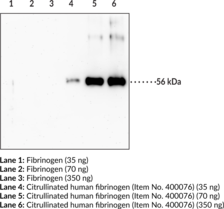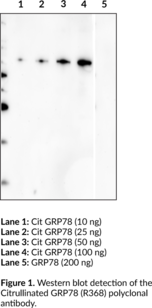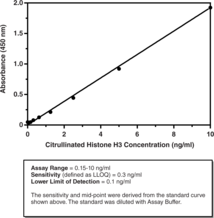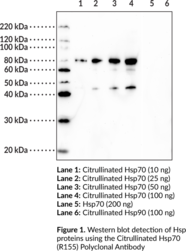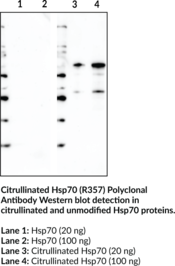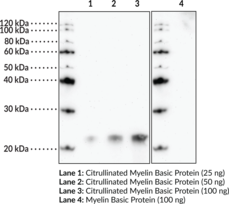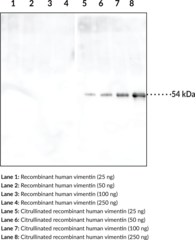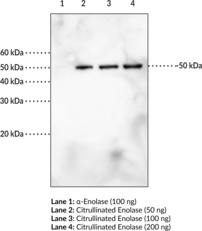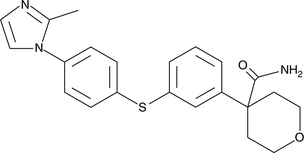Cayman
Showing 15601–15750 of 45550 results
-
Cisatracurium is a competitive antagonist of nicotinic acetylcholine receptors (nAChRs) and non-depolarizing muscle relaxant.{43025,43024} It inhibits stimulation of human adult muscle nAChRs by acetylcholine (Item No. 23829) with an IC50 value of 10 nM.{43025} It also inhibits mouse nAChRs with IC50 values of 54 and 115 nM for adult and embryonic receptors, respectively.{43027} Cisatracurium increases apoptosis in HUVEC cells and decreases proliferation of HepG2 and HUVEC cells in vitro in a concentration-dependent manner.{43028,43029} It reduces the magnitude of electrically-evoked twitch tensions in isolated rat extensor digitorum longus and soleus sciatic nerve muscle preparations in a dose-dependent manner.{43024} Cisatracurium blocks electrically-evoked muscle twitches in anesthetized rabbits with an ED95 value of 0.04 mg/kg.{43026} Formulations containing cisatracurium have been used to facilitate intubation prior to surgery and as muscle relaxants.
Brand:CaymanSKU:22959 - 50 mgAvailable on backorder
Cisplatin is a platinum-containing compound that acts as a DNA-crosslinking agent and interferes with replication and transcription, culminating in apoptosis.{25182} It forms intra- and interstrand crosslinks with DNA with intrastrand guanine-to-guanine or guanine-to-alanine links accounting for the majority of DNA binding.{39782} Cisplatin halts the cell cycle at the G2/M phase in vitro and is active against murine tumors transplanted into mice and in mouse xenograft models, including a reduction in tumor growth in a model of squamous cell carcinoma of the head and neck when administered at doses ranging from 7.5 to 12.5 mg/kg.{39783,39784} Cisplatin also inhibits the RecA recombinase of M. tuberculosis (IC50 = 2 µM), blocking protein splicing and cell growth.{26034} Formulations containing cisplatin have been used, alone and in combination therapy, in the treatment of a variety of cancers.
Brand:CaymanSKU:-Cisplatin is a platinum-containing compound that acts as a DNA-crosslinking agent and interferes with replication and transcription, culminating in apoptosis.{25182} It forms intra- and interstrand crosslinks with DNA with intrastrand guanine-to-guanine or guanine-to-alanine links accounting for the majority of DNA binding.{39782} Cisplatin halts the cell cycle at the G2/M phase in vitro and is active against murine tumors transplanted into mice and in mouse xenograft models, including a reduction in tumor growth in a model of squamous cell carcinoma of the head and neck when administered at doses ranging from 7.5 to 12.5 mg/kg.{39783,39784} Cisplatin also inhibits the RecA recombinase of M. tuberculosis (IC50 = 2 µM), blocking protein splicing and cell growth.{26034} Formulations containing cisplatin have been used, alone and in combination therapy, in the treatment of a variety of cancers.
Brand:CaymanSKU:-Cisplatin is a platinum-containing compound that acts as a DNA-crosslinking agent and interferes with replication and transcription, culminating in apoptosis.{25182} It forms intra- and interstrand crosslinks with DNA with intrastrand guanine-to-guanine or guanine-to-alanine links accounting for the majority of DNA binding.{39782} Cisplatin halts the cell cycle at the G2/M phase in vitro and is active against murine tumors transplanted into mice and in mouse xenograft models, including a reduction in tumor growth in a model of squamous cell carcinoma of the head and neck when administered at doses ranging from 7.5 to 12.5 mg/kg.{39783,39784} Cisplatin also inhibits the RecA recombinase of M. tuberculosis (IC50 = 2 µM), blocking protein splicing and cell growth.{26034} Formulations containing cisplatin have been used, alone and in combination therapy, in the treatment of a variety of cancers.
Brand:CaymanSKU:-Cisplatin is a platinum-containing compound that acts as a DNA-crosslinking agent and interferes with replication and transcription, culminating in apoptosis.{25182} It forms intra- and interstrand crosslinks with DNA with intrastrand guanine-to-guanine or guanine-to-alanine links accounting for the majority of DNA binding.{39782} Cisplatin halts the cell cycle at the G2/M phase in vitro and is active against murine tumors transplanted into mice and in mouse xenograft models, including a reduction in tumor growth in a model of squamous cell carcinoma of the head and neck when administered at doses ranging from 7.5 to 12.5 mg/kg.{39783,39784} Cisplatin also inhibits the RecA recombinase of M. tuberculosis (IC50 = 2 µM), blocking protein splicing and cell growth.{26034} Formulations containing cisplatin have been used, alone and in combination therapy, in the treatment of a variety of cancers.
Brand:CaymanSKU:-Citalopram is a selective serotonin (5-HT) reuptake inhibitor (SSRI) with an IC50 value of 1.8 nM for 5-HT reuptake in rat brain synaptosomes.{38122} It is selective for 5-HT reuptake over that of dopamine and norepinephrine (IC50s = >6 mM). Citalopram potentiates headweaving and tremor induced by 5-hydroxy-L-tryptophan (Item No. 20539) in mice (ED50s = 0.61 and 0.66 mmol/kg, respectively). It also acts as an antagonist of nicotinic acetylcholine receptors (IC50 = 0.93 µM).{23021} Formulations containing citalopram have been used to treat depression. This product is also available as an analytical reference standard (Item No. 23252).
Brand:CaymanSKU:-Citalopram is a selective serotonin (5-HT) reuptake inhibitor (SSRI) with an IC50 value of 1.8 nM for 5-HT reuptake in rat brain synaptosomes.{38122} It is selective for 5-HT reuptake over that of dopamine and norepinephrine (IC50s = >6 mM). Citalopram potentiates headweaving and tremor induced by 5-hydroxy-L-tryptophan (Item No. 20539) in mice (ED50s = 0.61 and 0.66 mmol/kg, respectively). It also acts as an antagonist of nicotinic acetylcholine receptors (IC50 = 0.93 µM).{23021} Formulations containing citalopram have been used to treat depression. This product is also available as an analytical reference standard (Item No. 23252).
Brand:CaymanSKU:-Citalopram is a selective serotonin (5-HT) reuptake inhibitor (SSRI) with an IC50 value of 1.8 nM for 5-HT reuptake in rat brain synaptosomes.{38122} It is selective for 5-HT reuptake over that of dopamine and norepinephrine (IC50s = >6 mM). Citalopram potentiates headweaving and tremor induced by 5-hydroxy-L-tryptophan (Item No. 20539) in mice (ED50s = 0.61 and 0.66 mmol/kg, respectively). It also acts as an antagonist of nicotinic acetylcholine receptors (IC50 = 0.93 µM).{23021} Formulations containing citalopram have been used to treat depression. This product is also available as an analytical reference standard (Item No. 23252).
Brand:CaymanSKU:-Citalopram-d4 (hydrobromide) is intended for use an internal standard for the quantification of citalopram (Item No. 14572) by GC- or LC-MS. Citalopram is a selective serotonin reuptake inhibitor which is commonly prescribed as an antidepressant.{23020,23022,23019} It also acts as an antagonist of nicotinic acetylcholine receptors (IC50 = 0.93 µM).{23021}
Brand:CaymanSKU:22102 -Out of stock
Citalopram-d4 (hydrobromide) is intended for use an internal standard for the quantification of citalopram (Item No. 14572) by GC- or LC-MS. Citalopram is a selective serotonin reuptake inhibitor which is commonly prescribed as an antidepressant.{23020,23022,23019} It also acts as an antagonist of nicotinic acetylcholine receptors (IC50 = 0.93 µM).{23021}
Brand:CaymanSKU:22102 -Out of stock
The constitutive androstane receptor (CAR) is a nuclear receptor that functions as a sensor of toxic compounds and enhances their elimination.{27663} CITCO is an agonist of human CAR (EC50 = 49 nM).{28128} It induces nuclear translocation of human CAR in hepatocytes, followed by increased expression of CAR-regulated genes, including several cytochrome P450 isoforms.{28128} CITCO less potently activates human pregnane X receptor (EC50 = 3 µM) and has no detectable activity on other nuclear receptors at 10 µM.{28128} It is selective for human CAR, whereas TCPOBOP (Item No. 14140) is selective for mouse CAR.{27663} CITCO does activate alternative splice variants of human CAR that are also found in liver cells.{28132} It is commonly used to study the action of human CAR in hepatocytes.{28130,28131}
Brand:CaymanSKU:-The constitutive androstane receptor (CAR) is a nuclear receptor that functions as a sensor of toxic compounds and enhances their elimination.{27663} CITCO is an agonist of human CAR (EC50 = 49 nM).{28128} It induces nuclear translocation of human CAR in hepatocytes, followed by increased expression of CAR-regulated genes, including several cytochrome P450 isoforms.{28128} CITCO less potently activates human pregnane X receptor (EC50 = 3 µM) and has no detectable activity on other nuclear receptors at 10 µM.{28128} It is selective for human CAR, whereas TCPOBOP (Item No. 14140) is selective for mouse CAR.{27663} CITCO does activate alternative splice variants of human CAR that are also found in liver cells.{28132} It is commonly used to study the action of human CAR in hepatocytes.{28130,28131}
Brand:CaymanSKU:-The constitutive androstane receptor (CAR) is a nuclear receptor that functions as a sensor of toxic compounds and enhances their elimination.{27663} CITCO is an agonist of human CAR (EC50 = 49 nM).{28128} It induces nuclear translocation of human CAR in hepatocytes, followed by increased expression of CAR-regulated genes, including several cytochrome P450 isoforms.{28128} CITCO less potently activates human pregnane X receptor (EC50 = 3 µM) and has no detectable activity on other nuclear receptors at 10 µM.{28128} It is selective for human CAR, whereas TCPOBOP (Item No. 14140) is selective for mouse CAR.{27663} CITCO does activate alternative splice variants of human CAR that are also found in liver cells.{28132} It is commonly used to study the action of human CAR in hepatocytes.{28130,28131}
Brand:CaymanSKU:-Citicoline is an endogenous intermediate in the synthesis of phosphatidylcholine, the major phospholipid in eukaryotic cells.{23421} It also serves as a choline donor in the biosynthesis of the neurotransmitter acetylcholine. Citicholine demonstrates protective effects in cerebral ischemia, traumatic brain injury, and memory disorders.{23420} Exogenous administration of citicholine to rodents (500 mg/kg i.p. immediately after ischemia and at 3-h reperfusion) has been shown to stimulate the synthesis of phosphatidylcholine, sphingomyelin, and cardiolipin and to attenuate the release of arachidonic acid and the accumulation of ceramide.{23419}
Brand:CaymanSKU:-Citicoline is an endogenous intermediate in the synthesis of phosphatidylcholine, the major phospholipid in eukaryotic cells.{23421} It also serves as a choline donor in the biosynthesis of the neurotransmitter acetylcholine. Citicholine demonstrates protective effects in cerebral ischemia, traumatic brain injury, and memory disorders.{23420} Exogenous administration of citicholine to rodents (500 mg/kg i.p. immediately after ischemia and at 3-h reperfusion) has been shown to stimulate the synthesis of phosphatidylcholine, sphingomyelin, and cardiolipin and to attenuate the release of arachidonic acid and the accumulation of ceramide.{23419}
Brand:CaymanSKU:-Citicoline is an endogenous intermediate in the synthesis of phosphatidylcholine, the major phospholipid in eukaryotic cells.{23421} It also serves as a choline donor in the biosynthesis of the neurotransmitter acetylcholine. Citicholine demonstrates protective effects in cerebral ischemia, traumatic brain injury, and memory disorders.{23420} Exogenous administration of citicholine to rodents (500 mg/kg i.p. immediately after ischemia and at 3-h reperfusion) has been shown to stimulate the synthesis of phosphatidylcholine, sphingomyelin, and cardiolipin and to attenuate the release of arachidonic acid and the accumulation of ceramide.{23419}
Brand:CaymanSKU:-Citicoline is an endogenous intermediate in the synthesis of phosphatidylcholine, the major phospholipid in eukaryotic cells.{23421} It also serves as a choline donor in the biosynthesis of the neurotransmitter acetylcholine. Citicholine demonstrates protective effects in cerebral ischemia, traumatic brain injury, and memory disorders.{23420} Exogenous administration of citicholine to rodents (500 mg/kg i.p. immediately after ischemia and at 3-h reperfusion) has been shown to stimulate the synthesis of phosphatidylcholine, sphingomyelin, and cardiolipin and to attenuate the release of arachidonic acid and the accumulation of ceramide.{23419}
Brand:CaymanSKU:-Brand:CaymanSKU:701041 - 15 mlAvailable on backorder
Citreoindole is a diketopiperazine metabolite isolated from a hybrid cell fusion of two strains of P. citreovirde that is cytotoxic in vitro against HeLa cells at 8.4 μM.{38031,38032}
Brand:CaymanSKU:22069 -Out of stock
Citreoindole is a diketopiperazine metabolite isolated from a hybrid cell fusion of two strains of P. citreovirde that is cytotoxic in vitro against HeLa cells at 8.4 μM.{38031,38032}
Brand:CaymanSKU:22069 -Out of stock
Citreoviridin is a mycotoxin isolated from several Penicillium species that has been shown to inhibit the mitochondrial ATP synthetase system.{26689,26688} It inhibits soluble ATPase (KD = 4.1 µM), ADP-stimulated respiration in isolated rat liver mitochondria (KD = 0.15 µM), and ATP-driven reduction of NAD+ by succinate (KD = 2 µM).{26689} Citreoviridin has been used to target ectopic ATPase activity in cancer cells in order to modulate the metabolic activity associated with tumorigenesis.{26690}
Brand:CaymanSKU:11319 - 1 mgAvailable on backorder
Citreoviridin is a mycotoxin isolated from several Penicillium species that has been shown to inhibit the mitochondrial ATP synthetase system.{26689,26688} It inhibits soluble ATPase (KD = 4.1 µM), ADP-stimulated respiration in isolated rat liver mitochondria (KD = 0.15 µM), and ATP-driven reduction of NAD+ by succinate (KD = 2 µM).{26689} Citreoviridin has been used to target ectopic ATPase activity in cancer cells in order to modulate the metabolic activity associated with tumorigenesis.{26690}
Brand:CaymanSKU:11319 - 5 mgAvailable on backorder
Citreoviridin is a mycotoxin isolated from several Penicillium species that has been shown to inhibit the mitochondrial ATP synthetase system.{26689,26688} It inhibits soluble ATPase (KD = 4.1 µM), ADP-stimulated respiration in isolated rat liver mitochondria (KD = 0.15 µM), and ATP-driven reduction of NAD+ by succinate (KD = 2 µM).{26689} Citreoviridin has been used to target ectopic ATPase activity in cancer cells in order to modulate the metabolic activity associated with tumorigenesis.{26690}
Brand:CaymanSKU:11319 - 500 µgAvailable on backorder
Citrinin is a mycotoxin that has been found in Monascus and has diverse biological activities.{58148,58149,58150,58151} It is active against S. aureus, methicillin-resistant S. aureus (MRSA), rifampicin-resistant S. aureus, and vancomycin-resistant E. faecium (MICs = 1.95, 3.9, 0.97, and 7.81 µg/ml, respectively), as well as the pathogenic yeast C. neoformans (MIC = 3.9 µg/ml).{58149} It is cytotoxic to a variety of cells in vitro, including bovine kidney cells and mice embryonic stem cells.{58151} Citrinin (30 µM) induces reactive oxygen species (ROS) production, mitochondrial membrane potential loss, and apoptosis in HepG2 cells, effects that can be blocked by the antioxidant resveratrol.{58150} In contrast, citrinin reduces glutamate-induced excitotoxicity in primary rat cortical neurons at concentrations ranging from 0.1 to 1,000 nM and inhibits LPS-induced production of nitric oxide (NO) in RAW 264.7 cells at 0.625 to 40 µM.{58151} It is toxic to brine shrimp larvae (LD50 = 96 µg/ml), as well as to rats and mice with oral LD50 values of 50 and 87-105 mg/kg, respectively.{58149,58151} It induces reproductive abnormalities in male mice and toxic effects in the liver, kidney, heart, and gastrointestinal tracts of various animals.{58151} Citrinin has been found in stored cereal grains, as well as beans, fruit, and herbs.
Brand:CaymanSKU:11320 - 1 mgAvailable on backorder
Citrinin is a mycotoxin that has been found in Monascus and has diverse biological activities.{58148,58149,58150,58151} It is active against S. aureus, methicillin-resistant S. aureus (MRSA), rifampicin-resistant S. aureus, and vancomycin-resistant E. faecium (MICs = 1.95, 3.9, 0.97, and 7.81 µg/ml, respectively), as well as the pathogenic yeast C. neoformans (MIC = 3.9 µg/ml).{58149} It is cytotoxic to a variety of cells in vitro, including bovine kidney cells and mice embryonic stem cells.{58151} Citrinin (30 µM) induces reactive oxygen species (ROS) production, mitochondrial membrane potential loss, and apoptosis in HepG2 cells, effects that can be blocked by the antioxidant resveratrol.{58150} In contrast, citrinin reduces glutamate-induced excitotoxicity in primary rat cortical neurons at concentrations ranging from 0.1 to 1,000 nM and inhibits LPS-induced production of nitric oxide (NO) in RAW 264.7 cells at 0.625 to 40 µM.{58151} It is toxic to brine shrimp larvae (LD50 = 96 µg/ml), as well as to rats and mice with oral LD50 values of 50 and 87-105 mg/kg, respectively.{58149,58151} It induces reproductive abnormalities in male mice and toxic effects in the liver, kidney, heart, and gastrointestinal tracts of various animals.{58151} Citrinin has been found in stored cereal grains, as well as beans, fruit, and herbs.
Brand:CaymanSKU:11320 - 10 mgAvailable on backorder
Citrinin is a mycotoxin that has been found in Monascus and has diverse biological activities.{58148,58149,58150,58151} It is active against S. aureus, methicillin-resistant S. aureus (MRSA), rifampicin-resistant S. aureus, and vancomycin-resistant E. faecium (MICs = 1.95, 3.9, 0.97, and 7.81 µg/ml, respectively), as well as the pathogenic yeast C. neoformans (MIC = 3.9 µg/ml).{58149} It is cytotoxic to a variety of cells in vitro, including bovine kidney cells and mice embryonic stem cells.{58151} Citrinin (30 µM) induces reactive oxygen species (ROS) production, mitochondrial membrane potential loss, and apoptosis in HepG2 cells, effects that can be blocked by the antioxidant resveratrol.{58150} In contrast, citrinin reduces glutamate-induced excitotoxicity in primary rat cortical neurons at concentrations ranging from 0.1 to 1,000 nM and inhibits LPS-induced production of nitric oxide (NO) in RAW 264.7 cells at 0.625 to 40 µM.{58151} It is toxic to brine shrimp larvae (LD50 = 96 µg/ml), as well as to rats and mice with oral LD50 values of 50 and 87-105 mg/kg, respectively.{58149,58151} It induces reproductive abnormalities in male mice and toxic effects in the liver, kidney, heart, and gastrointestinal tracts of various animals.{58151} Citrinin has been found in stored cereal grains, as well as beans, fruit, and herbs.
Brand:CaymanSKU:11320 - 5 mgAvailable on backorder
Citromycetin is a fungal metabolite originally isolated from P. frequentans with antibiotic activity against the Gram-positive bacteria S. aureus and the Gram-negative bacteria V. cholerae and S. flexneri (MICs = 64 µg/ml for both).{41375,41376} Citromycetin is selectively cytotoxic to cancerous cells over non-cancerous cells (LC50s = 9.21 and 261.14 µg/ml for HeLa and Vero cells, respectively). Formulations containing citromycetin have been studied for use in the treatment of amyloidosis and α-synuclein fibril diseases.{41374}
Brand:CaymanSKU:24175 - 1 mgAvailable on backorder
Citromycetin is a fungal metabolite originally isolated from P. frequentans with antibiotic activity against the Gram-positive bacteria S. aureus and the Gram-negative bacteria V. cholerae and S. flexneri (MICs = 64 µg/ml for both).{41375,41376} Citromycetin is selectively cytotoxic to cancerous cells over non-cancerous cells (LC50s = 9.21 and 261.14 µg/ml for HeLa and Vero cells, respectively). Formulations containing citromycetin have been studied for use in the treatment of amyloidosis and α-synuclein fibril diseases.{41374}
Brand:CaymanSKU:24175 - 5 mgAvailable on backorder
Citropten is a coumarin that has been found in bergamot extracts and has diverse biological activities.{48867,48868,48869,48870} It reduces IL-8 mRNA accumulation induced by TNF-α or heat-inactivated P. aeruginosa in IB3-1 cells derived from cystic fibrosis patients.{48867} Citropten induces cell cycle arrest at the G1 phase and inhibits proliferation of A375, MCF-7, PC3, and SW620 cancer cells (IC50s = 250-325 µM).{48868} It is active against various Gram-positive and Gram-negative bacteria (MICs = 16-64 µg/ml).{48869} Citropten increases prothrombin time in isolated rat platelet-poor plasma. In vivo, citropten (10 mg/kg) prevents decreases in locomotor activity and increases in hippocampal monoamine oxidase A (MAO-A) levels in a rat model of chronic mild stress-induced depression.{48870}
Brand:CaymanSKU:29338 - 1 gAvailable on backorder
Citropten is a coumarin that has been found in bergamot extracts and has diverse biological activities.{48867,48868,48869,48870} It reduces IL-8 mRNA accumulation induced by TNF-α or heat-inactivated P. aeruginosa in IB3-1 cells derived from cystic fibrosis patients.{48867} Citropten induces cell cycle arrest at the G1 phase and inhibits proliferation of A375, MCF-7, PC3, and SW620 cancer cells (IC50s = 250-325 µM).{48868} It is active against various Gram-positive and Gram-negative bacteria (MICs = 16-64 µg/ml).{48869} Citropten increases prothrombin time in isolated rat platelet-poor plasma. In vivo, citropten (10 mg/kg) prevents decreases in locomotor activity and increases in hippocampal monoamine oxidase A (MAO-A) levels in a rat model of chronic mild stress-induced depression.{48870}
Brand:CaymanSKU:29338 - 250 mgAvailable on backorder
Citropten is a coumarin that has been found in bergamot extracts and has diverse biological activities.{48867,48868,48869,48870} It reduces IL-8 mRNA accumulation induced by TNF-α or heat-inactivated P. aeruginosa in IB3-1 cells derived from cystic fibrosis patients.{48867} Citropten induces cell cycle arrest at the G1 phase and inhibits proliferation of A375, MCF-7, PC3, and SW620 cancer cells (IC50s = 250-325 µM).{48868} It is active against various Gram-positive and Gram-negative bacteria (MICs = 16-64 µg/ml).{48869} Citropten increases prothrombin time in isolated rat platelet-poor plasma. In vivo, citropten (10 mg/kg) prevents decreases in locomotor activity and increases in hippocampal monoamine oxidase A (MAO-A) levels in a rat model of chronic mild stress-induced depression.{48870}
Brand:CaymanSKU:29338 - 5 gAvailable on backorder
Citropten is a coumarin that has been found in bergamot extracts and has diverse biological activities.{48867,48868,48869,48870} It reduces IL-8 mRNA accumulation induced by TNF-α or heat-inactivated P. aeruginosa in IB3-1 cells derived from cystic fibrosis patients.{48867} Citropten induces cell cycle arrest at the G1 phase and inhibits proliferation of A375, MCF-7, PC3, and SW620 cancer cells (IC50s = 250-325 µM).{48868} It is active against various Gram-positive and Gram-negative bacteria (MICs = 16-64 µg/ml).{48869} Citropten increases prothrombin time in isolated rat platelet-poor plasma. In vivo, citropten (10 mg/kg) prevents decreases in locomotor activity and increases in hippocampal monoamine oxidase A (MAO-A) levels in a rat model of chronic mild stress-induced depression.{48870}
Brand:CaymanSKU:29338 - 500 mgAvailable on backorder
Immunogen: Human citrullinated fibrinogen • Host: Mouse • Species Reactivity: (+) Human • Cross Reactivity: (-) Human fibrinogen • Applications: ELISA, WB • MW = 56 kDa
Brand:CaymanSKU:17088- 100 µgFibrinogen is a hexameric glycoprotein that has roles in coagulation and hemostasis.{53514,53515} It is comprised of two sets of Aα, Bβ, and γ polypeptide chains encoded by FGA, FGB, and FGG, respectively, in humans.{53514} Fibrinogen is synthesized in hepatocytes and secreted into the plasma. Following thrombin-mediated cleavage of N-terminal fibrinopeptides from the Aα and Bβ chains, yielding the α and β chains, respectively, fibrinogen assembles into fibrin protofibrils and then mature fibers, which provide structure and viscoelasticity to blood clots.{53515,53516,53518} Mutations in FGA, FGB, or FGG have been found in patients with afibrinogenemia or hypofibrinogenemia.{53514} Elevated plasma fibrinogen levels are associated with an increased risk of cardiovascular disease.{53517} Fibrinogen can be citrullinated by protein arginine deiminase 2 (PAD2) and PAD4.{31655} Immune complexes containing citrullinated fibrinogen have been found in patients with anti-citrullinated protein antibody-positive rheumatoid arthritis.{21643} Cayman’s Citrullinated Fibrinogen Monoclonal Antibody (Clone 10E9.3) can be used for ELISA and Western blot (WB) applications. The antibody recognizes citrullinated fibrinogen at 56 kDa from human samples.
Brand:CaymanSKU:17088 - 100 µgAvailable on backorder
Immunogen: Human citrullinated fibrinogen • Host: Mouse • Species Reactivity: (+) Human • Cross Reactivity: (-) Human fibrinogen • Applications: ELISA, WB • MW = 56 kDa
Brand:CaymanSKU:17088- 100 µgAvailable on backorder
Citrullinated glial fibrillary acidic protein (citGFAP) is a citrullinated form of GFAP (Item No. 27353), a class III intermediate filament (IF) protein that is expressed in mature astrocytes and contributes to cytoskeletal structure and strength.{53009} GFAP can be citrullinated in a calcium-dependent manner on the arginine residue at position 270 (R270) and at R416 by protein arginine deiminase 1 (PAD1; Item No. 10784) and PAD2 (Item No. 10785).{53021} citGFAP levels are increased by the calcium ionophore ionomycin (Item No. 10004974) in an in vitro model of traumatic brain injury (TBI) using NHA CC-2565 human astrocytes and are induced by controlled cortical impact in the cerebral cortex in a rat model of TBI.{53020} It has been found in the hippocampus in a rat model of Alzheimer’s disease induced by amyloid-β (25-35), as well as in the retina in a mouse model of alkali-induced eye injury.{45561,45562} citGFAP has also been found in postmortem hippocampus from patients with Alzheimer’s disease, and citGFAP levels are increased in postmortem-derived brain lesions from patients with multiple sclerosis.{53021,35771} Cayman’s Citrullinated GFAP (R416) Monoclonal Antibody (Clone 4B8) can be used for ELISA, Immunohistochemistry, and Western blot applications. The antibody recognizes recombinant GFAP and citGFAP at 37 kDa.
Brand:CaymanSKU:27795 - 300 µgAvailable on backorder
Immunogen: A peptide from the C-terminal region of human GFAP citrullinated at R416 • Host: Mouse • Species Reactivity: (+) Human; other species not tested • Cross Reactivity: (+) Citrullinated GFAP (-) Native GFAP, other citrullinated proteins • Applications: ELISA, IHC, WB • MW: 37 kDa
Brand:CaymanSKU:27795- 300 µgAvailable on backorder
Immunogen: A peptide from the C-terminal region of human GFAP citrullinated at R416 • Host: Mouse • Species Reactivity: (+) Human; other species not tested • Cross Reactivity: (+) Citrullinated GFAP (-) Native GFAP, other citrullinated proteins • Applications: ELISA, IHC, WB • MW: 37 kDa
Brand:CaymanSKU:27795- 300 µgGlucose-regulated protein 78 kDa (GRP78) is a molecular chaperone that is ubiquitously expressed in the endoplasmic reticulum of mammalian cells.{36130,36131,36132} GRP78 can be citrullinated at its 27 arginine residues by protein deiminases (PADs).{37332} The accumulation of citrullinated proteins in vivo leads to the production of anti-citrullinated protein antibodies (ACPAs) which perpetuate the inflammatory process.{32067} In vitro, ACPAs bind to citrullinated GRP78 expressed on the cell surface of peripheral blood mononuclear cells PMBCs and U937 cells leading to the production of TNF-α.{37330},{37331} In a mouse model of collagen-induced arthritis (CIA), anti-citrullinated GRP78 antibodies are found in the serum.{37332} Pre-immunization with citrullinated GRP78 prior to CIA induction shortens the time to joint inflammation and increases arthritis scores compared with non-citrullinated GRP78-immunized and non-immunized control mice. In autoimmune diseases such as rheumatoid arthritis, patient-derived serum contains higher levels of anti-citrullinated GRP78 antibodies than serum derived from patients with systemic lupus erythematosus and healthy controls.{37332} The predicted size of GRP78 (R368) is approximately 78 kDa and Cayman’s Citrullinated GRP78 (R368) Polyclonal Antibody detects the citrullinated GRP78 protein but not native GRP78 by Western blot. Cayman’s Citrullinated GRP78 (R368) Polyclonal Antibody detects citrullinated GRP78 and does not detect unmodified GRP78.
Brand:CaymanSKU:24287 - 1 eaAvailable on backorder
Immunogen: Synthetic peptide corresponding to an internal region of human GRP78 with a citrulline at residue 368 • Host: Rabbit • Cross Reactivity: (+) Citrullinated GRP78 and citrullinated HSP70; (-) Unmodified GRP78, unmodified HSP70, and all other citrullinated proteins • Species Reactivity: (+) Human citrullinated GRP78 • Applications: ELISA and WB
Brand:CaymanSKU:24287- 1 eaAvailable on backorder
Immunogen: Synthetic peptide corresponding to an internal region of human GRP78 with a citrulline at residue 368 • Host: Rabbit • Cross Reactivity: (+) Citrullinated GRP78 and citrullinated HSP70; (-) Unmodified GRP78, unmodified HSP70, and all other citrullinated proteins • Species Reactivity: (+) Human citrullinated GRP78 • Applications: ELISA and WB
Brand:CaymanSKU:24287- 1 eaHistone H3 is citrullinated by peptidylarginine deiminase 4 (PAD4) at residues R2, R8, and R17 during the processes of epigenetic chromatin remodeling and neutrophil extracellular trap (NET) formation. In vitro, citrullinated H3 (CitH3) is released from neutrophils that have been stimulated with calcium ionophore during the process of NETosis, and can be freed from NETs by treatment with nuclease. The measurement of CitH3, either in cell lysates or released during NETosis can be used as a functional readout of pharmacological PAD inhibition.
Brand:CaymanSKU:501620 - 96 wellsAvailable on backorder
Heat shock protein 70s (Hsp70s) are abundant and stress-inducible 70 kDa molecular chaperone proteins encoded by a highly conserved, multigene family.{15480} They are monomeric proteins that can be divided into two functional domains: an N-terminal ATPase domain and a substrate binding domain that contains a highly conserved EEVD motif at its C-terminus. Hsp70s are found in the cytosol, nuclei, endoplasmic reticulum, mitochondria, and chloroplasts of eukaryotes, as well as in bacteria. They function as molecular chaperones that assist in a wide range of cellular processes, including refolding of aggregated or misfolded proteins, co- and post-translational folding and assembly of nascent peptides, membrane translocation of secretory and organellar proteins, controlling activity of regulatory nuclear receptors, kinases and transcription factors, as well as cooperativity with the Hsp90 chaperone system in eukaryotes.{36132} The Hsp70 chaperone cycle is ATP-dependent and initiated by transient interaction of the Hsp70 substrate binding domain with hydrophobic regions within a peptide or protein. It consists of an alteration between the low-affinity ATP-bound state with fast rates of substrate exchange and the high-affinity ADP bound state with slow rates of substrate exchange. Hsp70s are subject to a variety of post-translational modifications and their expression is upregulated under conditions of cellular stress and in a variety of disease states. Specifically, citrullinated Hsp70 peptides have been found in the synovial fluid of patients with rheumatoid arthritis.{31556} Cayman’s Citrullinated Hsp70 (R155) Polyclonal Antibody can be used for Western blot and ELISA applications.
Brand:CaymanSKU:24497 - 1 eaAvailable on backorder
Immunogen: Peptide from the internal region of human Hsp70 containing a citrulline at residue 155 • Host: Rabbit • Cross Reactivity: (+) Citrullinated Hsp70; (-) Hsp70, other citrullinated Hsp proteins • Species Reactivity: (+) Human; other species not tested • Applications: ELISA and WB
Brand:CaymanSKU:24497- 1 eaAvailable on backorder
Immunogen: Peptide from the internal region of human Hsp70 containing a citrulline at residue 155 • Host: Rabbit • Cross Reactivity: (+) Citrullinated Hsp70; (-) Hsp70, other citrullinated Hsp proteins • Species Reactivity: (+) Human; other species not tested • Applications: ELISA and WB
Brand:CaymanSKU:24497- 1 eaHeat shock protein 70s (Hsp70s) are abundant and stress-inducible 70 kDa molecular chaperone proteins encoded by a highly conserved, multigene family.{15480} They are monomeric proteins that can be divided into two functional domains: an N-terminal ATPase domain and a substrate binding domain that contains a highly conserved EEVD motif at its C-terminus. Hsp70s are found in the cytosol, nuclei, endoplasmic reticulum, mitochondria, and chloroplasts of eukaryotes, as well as in bacteria. They function as molecular chaperones that assist in a wide range of cellular processes, including refolding of aggregated or misfolded proteins, co- and post-translational folding and assembly of nascent peptides, membrane translocation of secretory and organellar proteins, controlling activity of regulatory nuclear receptors, kinases and transcription factors, as well as acting cooperatively with the Hsp90 chaperone system in eukaryotes.{36132} The Hsp70 chaperone cycle is ATP-dependent and initiated by transient interaction of the Hsp70 substrate binding domain with hydrophobic regions within a peptide or protein. It consists of an alteration between the low-affinity ATP-bound state with fast rates of substrate exchange and the high-affinity ADP bound state with slow rates of substrate exchange. Hsp70s are subject to a variety of post-translational modifications and their expression is upregulated under conditions of cellular stress and in a variety of disease states. Specifically, citrullinated Hsp70 peptides have been found in the synovial fluid of patients with rheumatoid arthritis.{31556} Cayman’s Citrullinated Hsp70 (R357) Polyclonal Antibody can be used for Western blot and ELISA applications.
Brand:CaymanSKU:23916 - 1 eaAvailable on backorder
Immunogen: Synthetic peptide corresponding to an internal region of human HSP70 with a citrulline at residue 357 • Host: Rabbit • Species Reactivity: (+) Human Hsp70 (R357) • Applications: ELISA and WB
Brand:CaymanSKU:23916- 1 eaAvailable on backorder
Immunogen: Synthetic peptide corresponding to an internal region of human HSP70 with a citrulline at residue 357 • Host: Rabbit • Species Reactivity: (+) Human Hsp70 (R357) • Applications: ELISA and WB
Brand:CaymanSKU:23916- 1 eaCitrullinated myelin basic protein (citMBP) is a citrullinated form of MBP, a protein that is integral to myelin stability in the CNS.{42873} MBP contains 19 arginine residues that can be citrullinated by peptidylarginine deiminases (PADs), decreasing the positive charge of MBP.{42873,42874} The loss of positive charge disrupts MBP-lipid interactions, leading to myelin destabilization and loss and increases its susceptibility for degradation. MBP is degraded by the myelin-associated protease cathepsin D, which leads to exposure and release of immunodominant epitopes.{42873,42875} The percentage of MBP that is citrullinated is increased in the postmortem brain from patients with multiple sclerosis (MS), with an even greater percentage citrullinated in Marburg disease, a more severe form of MS.{42873} citMBP isolated from patients with multiple sclerosis (MS) is degraded by cathepsin D at a higher rate than MBP isolated from healthy controls.{42873,42875} Cayman’s Citrullinated Myelin Basic Protein Polyclonal Antibody can be used for Western blot and ELISA applications. The antibody recognizes citMBP at 21 kDa from human samples, and was generated using a peptide immunogen containing citrullines at R122 and R130 (human myelin basic protein sequence, isoform 5).
Brand:CaymanSKU:26742 - 500 µlAvailable on backorder
Immunogen: Synthetic peptide from the internal region of human myelin basic protein (isoform 5) with citrullines at R122 and R130 • Host: Rabbit • Species Reactivity: (+) Human • Cross Reactivity: (+) Citrullinated myelin basic protein (-) Native myelin basic protein, other citrullinated proteins, carbamylated proteins • Applications: ELISA and WB • MW = 12-18 kDa
Brand:CaymanSKU:26742- 500 µlAvailable on backorder
Immunogen: Synthetic peptide from the internal region of human myelin basic protein (isoform 5) with citrullines at R122 and R130 • Host: Rabbit • Species Reactivity: (+) Human • Cross Reactivity: (+) Citrullinated myelin basic protein (-) Native myelin basic protein, other citrullinated proteins, carbamylated proteins • Applications: ELISA and WB • MW = 12-18 kDa
Brand:CaymanSKU:26742- 500 µlImmunogen: Citrullinated peptide sequence from an internal region of human vimentin • Clone Designation: 12G11 • Host: Mouse • Cross Reactivity: (+) Citrullinated vimentin; (-) Unmodified protein • Species Reactivity: (+) Human; other species not tested • Isotype: IgG1 • Applications: ELISA and WB,
Brand:CaymanSKU:22054- 100 µgAvailable on backorder
Immunogen: Citrullinated peptide sequence from an internal region of human vimentin • Clone Designation: 12G11 • Host: Mouse • Cross Reactivity: (+) Citrullinated vimentin; (-) Unmodified protein • Species Reactivity: (+) Human; other species not tested • Isotype: IgG1 • Applications: ELISA and WB,
Brand:CaymanSKU:22054- 100 µgVimentin is a cytoskeleton intermediate filament protein present in cells of mesenchymal origin, including leukocytes, endothelial cells, and smooth muscle cells. It is subject to citrullination by peptidyl arginine deiminase 2 (PAD2; Item No. 10785) under high calcium concentrations, which can occur during macrophage apoptosis.{31884} Citrullinated vimentin has been shown to have a role in the production of anti-citrullinated protein antibodies (ACPAs).{31884,31883,55252} ACPAs against citrullinated proteins, such as vimentin, are considered to be highly specific markers for rheumatoid arthritis and other autoimmune diseases.{31883,55252} Cayman’s Citrullinated Vimentin Monoclonal Antibody (Clone 12G11) can be used for Western blot and ELISA applications. The antibody recognizes citrullinated vimentin at ~54 kDa from human samples.
Brand:CaymanSKU:22054 - 100 µgAvailable on backorder
α-Enolase, also known as enolase 1, is a glycolytic enzyme that catalyzes the conversion of 2-phosphoglycerate to phosphoenolpyruvate.{42086} It is ubiquitously expressed in human tissues, including liver, spleen, kidney, and brain. α-Enolase is an autoantigen in asthma and Hashimoto’s encephalopathy, and has been found in the serum of pediatric patients with juvenile idiopathic arthritis.{42090,42091,42092,36062} α-Enolase can be citrullinated by peptidyl arginine deiminases (PADs) and citrullinated α-enolase has been found in the synovial fluid of rheumatoid arthritis patients.{32062} Cayman’s Citrullinated α-Enolase Polyclonal Antibody can be used for Western blot and ELISA applications. It detects citrullinated α-enolase at ~50 kDa in human samples.
Brand:CaymanSKU:25947 - 500 µlAvailable on backorder
Immunogen: Synthetic citrullinated peptide from the N-terminal region of human α-enolase • Host: Rabbit • Cross Reactivity:(+) Citrullinated α-enolase (-) minimal cross reactivity to unmodified α-enolase • Species Reactivity: (+) Human citrullinated α-enolase • Applications: ELISA and WB
Brand:CaymanSKU:25947- 500 µlAvailable on backorder
Immunogen: Synthetic citrullinated peptide from the N-terminal region of human α-enolase • Host: Rabbit • Cross Reactivity:(+) Citrullinated α-enolase (-) minimal cross reactivity to unmodified α-enolase • Species Reactivity: (+) Human citrullinated α-enolase • Applications: ELISA and WB
Brand:CaymanSKU:25947- 500 µlCitrulline-specific probe-biotin is an affinity probe that allows for detection or immobilization of citrullinated proteins through interaction with the biotin ligand. It contains a phenylglyoxal group that selectively labels citrulline over arginine at acidic pH.{26196} Citrulline-specific probe-biotin is a biotinylated form of citrulline-specific probe-rhodamine (Item No. 16172) that contains biotin in place of the rhodamine fluorophore.
Brand:CaymanSKU:-Available on backorder
Citrulline-specific probe-biotin is an affinity probe that allows for detection or immobilization of citrullinated proteins through interaction with the biotin ligand. It contains a phenylglyoxal group that selectively labels citrulline over arginine at acidic pH.{26196} Citrulline-specific probe-biotin is a biotinylated form of citrulline-specific probe-rhodamine (Item No. 16172) that contains biotin in place of the rhodamine fluorophore.
Brand:CaymanSKU:-Available on backorder
Citrulline-specific probe-biotin is an affinity probe that allows for detection or immobilization of citrullinated proteins through interaction with the biotin ligand. It contains a phenylglyoxal group that selectively labels citrulline over arginine at acidic pH.{26196} Citrulline-specific probe-biotin is a biotinylated form of citrulline-specific probe-rhodamine (Item No. 16172) that contains biotin in place of the rhodamine fluorophore.
Brand:CaymanSKU:-Available on backorder
Protein arginine deiminases (PADs) catalyze the posttranslational modification of arginine residues on proteins to form citrulline, which plays a large role in regulating gene expression.{18134} Abnormally high PAD activity has been observed in a host of human diseases.{18134,18137} Citrulline-specific probe-rhodamine is a highly sensitive, rhodamine phenylglyoxal-based fluorophore that specifically detects protein citrullination via a chemoselective reaction between glyoxal and citrulline.{26196} This chemical probe (comprised of a single isomer) is capable of reacting with any citrulline-containing protein and can be analyzed with fluorescent imaging (excitation 532 nm; emission 580 nm).{26196} When added at 100 µM for 30 minutes at acidic pH, this probe has a reported limit of detection of ~10 ng for citrullinated histone H3 and ~1 ng for autodeiminated PAD4.{26196}
Brand:CaymanSKU:-Protein arginine deiminases (PADs) catalyze the posttranslational modification of arginine residues on proteins to form citrulline, which plays a large role in regulating gene expression.{18134} Abnormally high PAD activity has been observed in a host of human diseases.{18134,18137} Citrulline-specific probe-rhodamine is a highly sensitive, rhodamine phenylglyoxal-based fluorophore that specifically detects protein citrullination via a chemoselective reaction between glyoxal and citrulline.{26196} This chemical probe (comprised of a single isomer) is capable of reacting with any citrulline-containing protein and can be analyzed with fluorescent imaging (excitation 532 nm; emission 580 nm).{26196} When added at 100 µM for 30 minutes at acidic pH, this probe has a reported limit of detection of ~10 ng for citrullinated histone H3 and ~1 ng for autodeiminated PAD4.{26196}
Brand:CaymanSKU:-Protein arginine deiminases (PADs) catalyze the posttranslational modification of arginine residues on proteins to form citrulline, which plays a large role in regulating gene expression.{18134} Abnormally high PAD activity has been observed in a host of human diseases.{18134,18137} Citrulline-specific probe-rhodamine is a highly sensitive, rhodamine phenylglyoxal-based fluorophore that specifically detects protein citrullination via a chemoselective reaction between glyoxal and citrulline.{26196} This chemical probe (comprised of a single isomer) is capable of reacting with any citrulline-containing protein and can be analyzed with fluorescent imaging (excitation 532 nm; emission 580 nm).{26196} When added at 100 µM for 30 minutes at acidic pH, this probe has a reported limit of detection of ~10 ng for citrullinated histone H3 and ~1 ng for autodeiminated PAD4.{26196}
Brand:CaymanSKU:-Prostaglandin E2 (PGE2) activates four E prostanoid (EP) receptors, EP1-4. EP4 is a Gs protein-coupled receptor that, by elevating the second messenger cAMP, plays important roles in bone formation and resorption, cancer, and atherosclerosis.{16619,16772,16773} CJ-023423 is a potent and selective antagonist of the EP4 receptor (Ki = 13 and 20 nM for human and rat EP4, respectively).{14958,26175} It inhibits PGE2-evoked elevation in intracellular cAMP in cells and, in vivo, reduces thermal hyperalgesia induced by intraplantar injection of PGE2.{14958} CJ-023423 reduces acute and chronic inflammatory pain in different mouse models.{14958}
Brand:CaymanSKU:10010355 - 1 mgAvailable on backorder
Prostaglandin E2 (PGE2) activates four E prostanoid (EP) receptors, EP1-4. EP4 is a Gs protein-coupled receptor that, by elevating the second messenger cAMP, plays important roles in bone formation and resorption, cancer, and atherosclerosis.{16619,16772,16773} CJ-023423 is a potent and selective antagonist of the EP4 receptor (Ki = 13 and 20 nM for human and rat EP4, respectively).{14958,26175} It inhibits PGE2-evoked elevation in intracellular cAMP in cells and, in vivo, reduces thermal hyperalgesia induced by intraplantar injection of PGE2.{14958} CJ-023423 reduces acute and chronic inflammatory pain in different mouse models.{14958}
Brand:CaymanSKU:10010355 - 10 mgAvailable on backorder
Prostaglandin E2 (PGE2) activates four E prostanoid (EP) receptors, EP1-4. EP4 is a Gs protein-coupled receptor that, by elevating the second messenger cAMP, plays important roles in bone formation and resorption, cancer, and atherosclerosis.{16619,16772,16773} CJ-023423 is a potent and selective antagonist of the EP4 receptor (Ki = 13 and 20 nM for human and rat EP4, respectively).{14958,26175} It inhibits PGE2-evoked elevation in intracellular cAMP in cells and, in vivo, reduces thermal hyperalgesia induced by intraplantar injection of PGE2.{14958} CJ-023423 reduces acute and chronic inflammatory pain in different mouse models.{14958}
Brand:CaymanSKU:10010355 - 25 mgAvailable on backorder
Prostaglandin E2 (PGE2) activates four E prostanoid (EP) receptors, EP1-4. EP4 is a Gs protein-coupled receptor that, by elevating the second messenger cAMP, plays important roles in bone formation and resorption, cancer, and atherosclerosis.{16619,16772,16773} CJ-023423 is a potent and selective antagonist of the EP4 receptor (Ki = 13 and 20 nM for human and rat EP4, respectively).{14958,26175} It inhibits PGE2-evoked elevation in intracellular cAMP in cells and, in vivo, reduces thermal hyperalgesia induced by intraplantar injection of PGE2.{14958} CJ-023423 reduces acute and chronic inflammatory pain in different mouse models.{14958}
Brand:CaymanSKU:10010355 - 5 mgAvailable on backorder
CJ-13610 is an inhibitor of 5-lipoxygenase (5-LO) that inhibits 5-LO product formation in human polymorphonuclear leukocytes (PMNLs) challenged with A23187 (Item No. 11016) in vitro (IC50 = 70 nM).{38804} It inhibits recombinant 5-LO in a glutathione peroxidase-dependent manner (IC50 = 300 nM). CJ-13610 also inhibits 5-LO product formation induced by phosphorylation in PMNLs and HeLa cells. In vivo, CJ-13610 (3-10 mg/kg) reduces levels of leukotriene B4 (LTB4; Item No. 20110) and decreases mechanical hyperalgesia in a rat model of chronic inflammatory pain induced by Freund’s adjuvant.{38805} It also reverses tactile allodynia and increases hind paw weight bearing in a rat medial meniscal transection model of osteoarthritic pain when administered at doses ranging from 0.6 to 6 mg/kg.
Brand:CaymanSKU:21764 -Out of stock
CJ-13610 is an inhibitor of 5-lipoxygenase (5-LO) that inhibits 5-LO product formation in human polymorphonuclear leukocytes (PMNLs) challenged with A23187 (Item No. 11016) in vitro (IC50 = 70 nM).{38804} It inhibits recombinant 5-LO in a glutathione peroxidase-dependent manner (IC50 = 300 nM). CJ-13610 also inhibits 5-LO product formation induced by phosphorylation in PMNLs and HeLa cells. In vivo, CJ-13610 (3-10 mg/kg) reduces levels of leukotriene B4 (LTB4; Item No. 20110) and decreases mechanical hyperalgesia in a rat model of chronic inflammatory pain induced by Freund’s adjuvant.{38805} It also reverses tactile allodynia and increases hind paw weight bearing in a rat medial meniscal transection model of osteoarthritic pain when administered at doses ranging from 0.6 to 6 mg/kg.
Brand:CaymanSKU:21764 -Out of stock
CJ-13610 is an inhibitor of 5-lipoxygenase (5-LO) that inhibits 5-LO product formation in human polymorphonuclear leukocytes (PMNLs) challenged with A23187 (Item No. 11016) in vitro (IC50 = 70 nM).{38804} It inhibits recombinant 5-LO in a glutathione peroxidase-dependent manner (IC50 = 300 nM). CJ-13610 also inhibits 5-LO product formation induced by phosphorylation in PMNLs and HeLa cells. In vivo, CJ-13610 (3-10 mg/kg) reduces levels of leukotriene B4 (LTB4; Item No. 20110) and decreases mechanical hyperalgesia in a rat model of chronic inflammatory pain induced by Freund’s adjuvant.{38805} It also reverses tactile allodynia and increases hind paw weight bearing in a rat medial meniscal transection model of osteoarthritic pain when administered at doses ranging from 0.6 to 6 mg/kg.
Brand:CaymanSKU:21764 -Out of stock
CJ-13610 is an inhibitor of 5-lipoxygenase (5-LO) that inhibits 5-LO product formation in human polymorphonuclear leukocytes (PMNLs) challenged with A23187 (Item No. 11016) in vitro (IC50 = 70 nM).{38804} It inhibits recombinant 5-LO in a glutathione peroxidase-dependent manner (IC50 = 300 nM). CJ-13610 also inhibits 5-LO product formation induced by phosphorylation in PMNLs and HeLa cells. In vivo, CJ-13610 (3-10 mg/kg) reduces levels of leukotriene B4 (LTB4; Item No. 20110) and decreases mechanical hyperalgesia in a rat model of chronic inflammatory pain induced by Freund’s adjuvant.{38805} It also reverses tactile allodynia and increases hind paw weight bearing in a rat medial meniscal transection model of osteoarthritic pain when administered at doses ranging from 0.6 to 6 mg/kg.
Brand:CaymanSKU:21764 -Out of stock
Prostaglandin E2 (PGE2) activates four E prostanoid (EP) receptors, EP1-4. EP4 is a Gs protein-coupled receptor that, by elevating the second messenger cAMP, plays important roles in bone formation and resorption, cancer, and atherosclerosis.{16772,16773,16619} CJ-42794 is a selective antagonist of EP4 (Ki = 3.16 nM) that less potently binds EP2 (Ki = 631 nM) and has no affinity for EP1 or EP3.{14996,26030} It has minimal effect on numerous other receptors, enzymes, or channels.{26030} Unlike general inhibitors of PGE2 synthesis, CJ-42794 does not cause damage to rat gastrointestinal mucosa.{14996} Instead, it delays the healing of gastric ulcers in mice and rats, suppressing the upregulation of VEGF expression and angiogenesis.{26032} CJ-42794 blocks pain and inflammation in rat models of arthritis as well as gastric tumorigenesis in mice.{25895,26031}
Brand:CaymanSKU:10010428 - 10 mgAvailable on backorder
Prostaglandin E2 (PGE2) activates four E prostanoid (EP) receptors, EP1-4. EP4 is a Gs protein-coupled receptor that, by elevating the second messenger cAMP, plays important roles in bone formation and resorption, cancer, and atherosclerosis.{16772,16773,16619} CJ-42794 is a selective antagonist of EP4 (Ki = 3.16 nM) that less potently binds EP2 (Ki = 631 nM) and has no affinity for EP1 or EP3.{14996,26030} It has minimal effect on numerous other receptors, enzymes, or channels.{26030} Unlike general inhibitors of PGE2 synthesis, CJ-42794 does not cause damage to rat gastrointestinal mucosa.{14996} Instead, it delays the healing of gastric ulcers in mice and rats, suppressing the upregulation of VEGF expression and angiogenesis.{26032} CJ-42794 blocks pain and inflammation in rat models of arthritis as well as gastric tumorigenesis in mice.{25895,26031}
Brand:CaymanSKU:10010428 - 100 mgAvailable on backorder
Prostaglandin E2 (PGE2) activates four E prostanoid (EP) receptors, EP1-4. EP4 is a Gs protein-coupled receptor that, by elevating the second messenger cAMP, plays important roles in bone formation and resorption, cancer, and atherosclerosis.{16772,16773,16619} CJ-42794 is a selective antagonist of EP4 (Ki = 3.16 nM) that less potently binds EP2 (Ki = 631 nM) and has no affinity for EP1 or EP3.{14996,26030} It has minimal effect on numerous other receptors, enzymes, or channels.{26030} Unlike general inhibitors of PGE2 synthesis, CJ-42794 does not cause damage to rat gastrointestinal mucosa.{14996} Instead, it delays the healing of gastric ulcers in mice and rats, suppressing the upregulation of VEGF expression and angiogenesis.{26032} CJ-42794 blocks pain and inflammation in rat models of arthritis as well as gastric tumorigenesis in mice.{25895,26031}
Brand:CaymanSKU:10010428 - 250 mgAvailable on backorder
Prostaglandin E2 (PGE2) activates four E prostanoid (EP) receptors, EP1-4. EP4 is a Gs protein-coupled receptor that, by elevating the second messenger cAMP, plays important roles in bone formation and resorption, cancer, and atherosclerosis.{16772,16773,16619} CJ-42794 is a selective antagonist of EP4 (Ki = 3.16 nM) that less potently binds EP2 (Ki = 631 nM) and has no affinity for EP1 or EP3.{14996,26030} It has minimal effect on numerous other receptors, enzymes, or channels.{26030} Unlike general inhibitors of PGE2 synthesis, CJ-42794 does not cause damage to rat gastrointestinal mucosa.{14996} Instead, it delays the healing of gastric ulcers in mice and rats, suppressing the upregulation of VEGF expression and angiogenesis.{26032} CJ-42794 blocks pain and inflammation in rat models of arthritis as well as gastric tumorigenesis in mice.{25895,26031}
Brand:CaymanSKU:10010428 - 50 mgAvailable on backorder
CJC-1295 is a synthetic peptide derivative of growth hormone-releasing hormone (GHRH).{58178} Unlike CJC-1295-DAC, CJC-1295 does not contain a drug affinity complex (DAC) moiety and has a shorter half-life than the DAC-conjugated version in the blood.{58179} CJC-1295 increases the secretion of growth hormone in primary rat anterior pituitary cells when used from picomolar to micromolar concentrations and into rat blood when administered subcutaneously at a dose of 1 µmol/kg.{58178}
Brand:CaymanSKU:32704 - 100 mgAvailable on backorder
CJC-1295 is a synthetic peptide derivative of growth hormone-releasing hormone (GHRH).{58178} Unlike CJC-1295-DAC, CJC-1295 does not contain a drug affinity complex (DAC) moiety and has a shorter half-life than the DAC-conjugated version in the blood.{58179} CJC-1295 increases the secretion of growth hormone in primary rat anterior pituitary cells when used from picomolar to micromolar concentrations and into rat blood when administered subcutaneously at a dose of 1 µmol/kg.{58178}
Brand:CaymanSKU:32704 - 25 mgAvailable on backorder
CJC-1295 is a synthetic peptide derivative of growth hormone-releasing hormone (GHRH).{58178} Unlike CJC-1295-DAC, CJC-1295 does not contain a drug affinity complex (DAC) moiety and has a shorter half-life than the DAC-conjugated version in the blood.{58179} CJC-1295 increases the secretion of growth hormone in primary rat anterior pituitary cells when used from picomolar to micromolar concentrations and into rat blood when administered subcutaneously at a dose of 1 µmol/kg.{58178}
Brand:CaymanSKU:32704 - 5 mgAvailable on backorder
CJC-1295 is a synthetic peptide derivative of growth hormone-releasing hormone (GHRH).{58178} Unlike CJC-1295-DAC, CJC-1295 does not contain a drug affinity complex (DAC) moiety and has a shorter half-life than the DAC-conjugated version in the blood.{58179} CJC-1295 increases the secretion of growth hormone in primary rat anterior pituitary cells when used from picomolar to micromolar concentrations and into rat blood when administered subcutaneously at a dose of 1 µmol/kg.{58178}
Brand:CaymanSKU:32704 - 50 mgAvailable on backorder
CK 869 is an inhibitor of actin polymerization via inhibition of the actin-related protein 2/3 (Arp2/3) complex, leading to reduced cell motility rate and rearrangement of F-actin in M-1 cells.{34274} It inhibits comet tail formation by L. monocytogenes with an IC50 value of 7 µM.{27974} It also impairs cell adhesion and cell spreading in MCF10A human breast epithelial cells.{34273}
Brand:CaymanSKU:-CK 869 is an inhibitor of actin polymerization via inhibition of the actin-related protein 2/3 (Arp2/3) complex, leading to reduced cell motility rate and rearrangement of F-actin in M-1 cells.{34274} It inhibits comet tail formation by L. monocytogenes with an IC50 value of 7 µM.{27974} It also impairs cell adhesion and cell spreading in MCF10A human breast epithelial cells.{34273}
Brand:CaymanSKU:-












